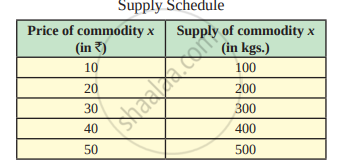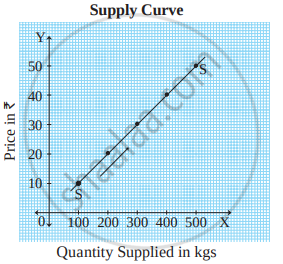Topics
The Productive Mechanism
Factors of Production
- Meaning of Production Mechanism
- Factors of Production - Land
- Factors of Production: Labour
- Factors of Production: Capital
- Factors of Production Entrepreneur
Theory of Demand and Supply
Elementary Theory of Demand
- Concept for Demand
- Types of Demand
- Individual Demand and Market Demand
- Determinants of Demand Or Demand Function
- Individual Demand Function
- Market Demand Function
- Law of Demand
- Statement of the Law of Demand
- Assumptions of Law of Demand
- Explanation of the Law of Demand
- Causes of Operation of Law of Demand
- Exceptions to the Law of Demand
- Changes in Demand
- Causes Behind Shifts of Demand Curve
- Distinction Between Extension of Demand and Increase in Demand
- Distinction Between Contraction of Demand and Decrease in Demand
Elasticity of Demand
- Elasticity of Demand
- Percentage Method of Measuring Price Elasticity of Demand
- Degrees (Or Kinds) of Price Elasticity of Demand
- Factors Affecting Price Elasticity of Demand
- Types of Elasticity of Demand
Market
Banking in India
Theory of Supply
- Concept of Supply
- Difference Between Supply and Stock
- Types of Supply
- Factors Affecting Supply (Or Determinants of Supply)
- Supply Schedule
- Supply Curve
- Law of Supply
- Statement of the Law of Supply
- Assumptions of the Law of Supply
- Explanation of the Law of Supply
- Reasons Behind the Operation of the Law of Supply
- Exceptions to the Law of Supply
- Change in Quantity Supplied (Or Movements Along the Supply Curve)
- Change in Supply (Or Shifts of Supply Curve)
- Distinction Between Change in Quantity Supplied (Or Movement Along Supply Curve and Change in Supply Or Shift of the Supply Curve)
- Distinction Between Expansion in Supply and Increase in Supply
- Distinction Between Contraction in Supply and Decrease in Supply
- Elasticity of Supply
Demonetisation
- Demonetisation
Inflation
Meaning and Types of Markets
- Concept of Market
- Forms of Market Structure
- Perfect Competition
- Monopoly
- Monopolistic Competition
- Oligopoly
- Monopsony
- Distinction Between Perfect Competition, Monopoly and Monopolistic Competition
- Similarities Between Monopolistic Competition and Perfect Competition
- Similarities Between Monopolistic Competition and Monopoly
Meaning and Functions of Money
- Meaning and Functions of Money
- Concept for Barter System
- Evolution of Money
- Forms of Money
- Features of Money
- Secondary Functions
- Functions of Money
- Primary Function
- Secondary Functions
- Contingent Function
Consumer Awareness
Commercial Banks
- Meaning of Commercial Banks
- Importance of Banks
- Functions of Commercial Banks
- Primary Functions
- Agency Functions
- General Utility Functions
- Concept of Credit Creation
- Nationalisation of Banks
Central Bank
- Quantitative and Qualitative Credit Control Measures Adopted by RBI
- Central Bank Function - Banker's Bank
- Central Bank Function - Goverment Bank
- Meaning of Central Bank
- Differences Between a Central Bank and a Commercial Bank
- Need for a Central Bank
- Functions of a Central Bank
- Monetary Policy of the Central Bank
- Quantitative Methods
- Qualitative (Or Selective) Methods
- Demonetisation
Introduction to Public Finance
- Meaning and Scope of Public Finance
- Nature of Public Finance
- Public Finance and Private Finance
Public Revenue
- Meaning of Public Revenue
- Significance of Public Revenue
- Sources of Public Revenue
- Objectives and Significance of Taxes
- Concept of Direct Taxes
- Concept of Indirect Taxes
- Goods and Service Tax (Gst)
- Objectives (Or Benefits) of Gst
- Other Kinds of Taxes
- Specific and Advalorem Taxes
- Concept for Proportional Tax
- Concept for Progressive Tax
- Concept for Regressive Tax
- Concept for Digressive Tax
Public Expenditure
- Concept for Public Expenditure
- Types of Public Expenditure
- Revenue Expenditure and Capital Expenditure
- Developmental and Non-developmental Expenditure
- Productive and Unproductive Expenditure
- Reasons for the Growth of Public Expenditure
- Objectives of Public Expenditure
- Role of Public Expenditure in Economic Development
Public Debt
- Meaning of Public Debt
- Difference Between Public and Private Debts
- Types of Public Debt
Inflation
- Introduction of Inflation
- Wholesale Price Index (WPI)
- Consumer Price Index (CPI)
- Food Basket
- Relationship Between Value of Money and Price Level
- Types of Inflation
- Demand Pull Inflation
- Cost Push Inflation
- Effects of Inflation
Consumer Awareness
- Factors Causing Exploitation of Consumers
- Rise of Consumer Awareness
- Legal Measures Available to Protect Consumers from Being Exploited (COPRA, RTI)
- Awareness of Food Adulteration and Its Harmful Effects
- Consumer Awareness
- Consumer is Exploitation
- Consumer Movement
- Concept of Consumer Rights
- Food Adulteration
- Consumer Protection Act 1986 (COPRA)
- Right to Information Act 2005
- Understanding the Importance of Educating Consumers of Their Rights
- Consumer Duties
- Standardisation of Product
Notes
Assumptions of the law :
The law of supply is based on the following assumptions :
1) Constant cost of production :
It is assumed that there is no change in the cost of production .A change in cost of production will affect the profits of the seller. Therefore less quantity will be supplied at the same price.
2) Constant technique of production :
It is also assumed that technique of production does not change. Improved technique of production may lead to an increase in production. This in turn may lead to an increase in the supply at the same price.
3) No change in weather conditions :
It is assumed that there is no change in the weather conditions. Natural calamities like floods, earthquakes etc. may decrease supply.
4) No change in Government policy :
It is also assumed that government policies like taxation policy, trade policy etc. remain unchanged.
5) No change in transport cost :
It is assumed that there is no change in the condition of transport facilities and transport cost. For example, better transport facility increases supply at the same price.
6) Prices of other goods remain constant :
Prices of other goods are assumed to remain constant. If they change, the law of supply may not hold true because producer may transfer resources to other products.
7) No future expectations :
The law also assumes that the sellers do not expect future changes in the price of the product.
Law of supply is explained with the help of the following schedule and diagram :

It explains the direct relationship between price and quantity of commodity supplied. When price rises from ₹10 to ₹20, 30,40 and 50, the supply also rises from 100 to 200,300, 400 and 500 units respectively. It means, when price rises supply also rises and when price falls supply also falls. Thus, there is direct relationship between price and quantity supplied which is shown in following figure:

In the figure above, X axis represents quantity supplied and Y axis represents the price of the commodity. Supply curve 'SS' slopes upwards from left to right which has a positive slope. It indicates a direct relationship between price and quantity supplied.
